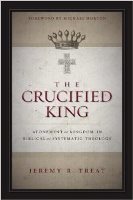We cannot read the New Testament even cursorily without noticing the prominence of the themes of both the kingdom of God and the cross of Christ. We can scarcely miss that Jesus is presented both as reigning king and as crucified in utter humiliation. These themes are familiar to any who read the Gospels. But just how do these seemingly mutually exclusive themes fit together?
Similarly, on any reading of Scripture we cannot miss the point that Christ came to die for our sins and that he came to destroy the works of the devil. Once again, just how do these themes fit together?
Glory and humiliation. Victory and defeat. Power and weakness. A crown and a cross. We all know that these paradoxical themes somehow come together in Christ, but Dr. Jeremy Treat (Pastor at Reality LA in Hollywood, CA, and adjunct professor at Biola) has perhaps more thoroughly than anyone else written to explain how Christ is The Crucified King. We found it a fascinating read, and we’re happy to have Dr. Treat here with us today to talk to us about his new work.
Books At a Glance (Fred Zaspel):
First, tell us about the background to this study. Has this theme long been an area of interest to you? A rather new interest? How did you come to settle on this theme?
Treat:
This project started for me for by making a simple observation in the church: “cross-centered” people rarely spoke of the kingdom of God and the “kingdom-minded” folks hardly ever mentioned the cross (at least not the parts about sin and wrath). I even recognized this dichotomy in myself. Having grown up in a very conservative church, I remember one day being confronted with the fact that the kingdom of God was the number one thing Jesus talked about and yet it played zero role in my theology or my understanding of what it means to be a Christian.
When I turned to scholarship for help I found more of the same, although not necessarily for the same reasons. Tomes on the kingdom of God would never even mention the atoning work of Christ. Book after book on the atonement ignored the entire Old Testament promises and New Testament preaching about the kingdom of God.
So I set out myself to answer the question: How do the coming of God’s kingdom and Christ’s atoning death on the cross relate? By God’s grace, I was able to dedicate three years of my life to this project in a great doctoral program (Wheaton College) under the guidance of some of my own theological heroes (Kevin Vanhoozer and Doug Moo).
Books At a Glance:
Can you summarize your thesis for us briefly? What is it you are after in this book?
Treat:
While many either cling to the cross or champion the kingdom, I try to show that you can’t understand one apart from the other. The kingdom is the goal of the cross and the cross is the means by which the kingdom comes. My thesis, in briefest form, is that the kingdom comes by way of the cross. Within the broader spectrum of Christ’s work (incarnation, life, resurrection, ascension, and session – all of which are extremely important), the cross is the defining moment in the coming of God’s redemptive rule. Scripture presents a mutually enriching relationship between the kingdom and atonement that draws significantly from the story of Israel and culminates in the crucifixion of Christ the king.
 Books At a Glance:
Books At a Glance:
Let’s talk Biblical Theology. How does the Bible’s storyline bring this theme into focus?
Treat:
The kingdom and the cross are ultimately held together by the Christ. But Jesus is a man with a story, and you can’t understand what he said or did regarding the kingdom and the cross apart from his life being the fulfillment of Israel’s hopes and dreams. The “kingdom of God” (Mark 1:15) and Christ’s death “for our sins” (1 Cor 15:3) may emerge in the New Testament as fully blossomed concepts, but they are truly the fruit of roots that have grown in the soil of the Old Testament and are constantly intertwined.
I walk through the canon of Scripture, trying to show that from Gen 3:15 forward, victory and suffering are intertwined throughout the story. As the narrative unfolds, the promised victory develops into royal victory and the suffering into atoning suffering, and these themes converge in the suffering servant of Isaiah who accomplishes a royal victory through atoning suffering.
With this background in mind, it makes sense that Jesus shows up with a kingdom mission that is headed straight for the cross. Through the cross, Jesus pays the penalty for sin, thereby reconciling sinners to God and dethroning the enemy. From the bruised heel of Genesis (3:15) to the reigning lamb of Revelation (22:1), the Bible is a redemptive story of a crucified messiah who will accomplish a royal victory through atoning suffering.
Books At a Glance:
How is this theme shaped by categories of Systematic Theology? How are penal substitution and the ancient theme of Christus Victor related?
Treat:
The unfortunate trend has in systematic theology has been to pit atonement theories against one another: on the cross Jesus either conquered sin and Satan or removed guilt or offered an example of self-giving love. But according to the biblical story of redemption, Jesus’ atoning death is a multifaceted accomplishment. The glory of the cross cannot be reduced to only one aspect of its accomplishment.
Penal substitution and Christus Victor have been the leading “theories” of atonement and they’ve often times been presented as mutually exclusive. I try to show that not only do we need to uphold the victory and propitiation of the cross, we need to understand how they fit together. I argue that Christ’s penal-substitutionary death is the means for his victory on the cross—Christus Victor through penal substitution. Yes, Jesus is victorious on the cross; but how does he accomplish this victory? It’s not by brute force. There are many different parts to this argument, but the most obvious is that Satan’s power over humanity is his power of accusation. But when Jesus, as the substitute pays the penalty for sin and satisfies God’s justice, Satan is disarmed of his accusatory power. In Christ we are innocent and righteous.
Inasmuch as the coming of God’s kingdom entails God’s defeat of evil and reconciliation of sinners, Christus Victor and penal substitution are both essential aspects to Christ’s kingdom-establishing death on the cross.
Books At a Glance:
Especially since Calvin we have been accustomed to understanding Christ in terms of his three-fold office of Prophet, Priest, and King. How has this framework tended to help or hinder our understanding of the “crucified King”?
Treat:
I’m a big fan of the threefold office. I think it’s a way of understanding Christ that draws from the story of Israel and emphasizes the multifaceted nature of Christ’s person and work. But unfortunately, the threefold office has often been over-systematized: Jesus is a prophet in his life, a priest in his death, and a king in his resurrection. Although there may be a hint of truth here, these clear lines separate what Scripture holds together. According to Scripture, Jesus is anointed as king at his baptism (Matt 3:13–17); recognized as a king throughout his ministry (John 1:49; 6:15); and, as the triumphal entry makes clear (Matt 21:1–11), Jesus approaches the cross as king seeking to establish his kingdom. The gospel writers are bent on showing that the cross is a royal accomplishment. In the gospel of Mark, for example, half of the uses of the word “king” show up in the crucifixion account in Mark 15. What fallen human understanding fails to perceive, the centurion below the cross recognized: “truly this is the son of God”—a royal title, for sure.
So let’s use the threefold office, but in a way where we uphold the importance of all three offices and where they are integrated in our understanding of the person and work of Christ.
Note: See our review of The Crucified King here.

